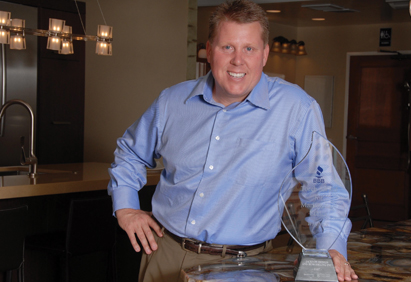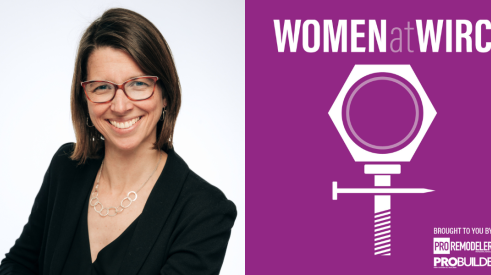The tricky market conditions of the past few years have prompted many remodelers to try to become jacks-of-all-trades to chase every job out there.
Not Todd R. Jackson, president and CEO of Jackson Design and Remodeling (JDR) in San Diego.
Over the past two decades, Jackson has gone from a generalist who did it all to a specialist who has a well-defined and uniquely executed expertise in design-build. The process has taken his company through several rebranding efforts and a name change when they shed Jackson Construction and Renovation in 2000. "Today, design is who we are. And very few firms do what we do," Jackson points out.
What they do is so distinctive that it has won them myriad awards for design and performance, including 19 COtY awards from NARI and GuildQuality's highest honor, Guild Master with highest distinction--which they have bagged for the last three years in a row.
Additionally, they have earned an extraordinarily high level of customer loyalty. Over a four-year period, ninety-seven percent of their customers responded to GuildQuality's satisfaction surveys and gave them a 97 percent approval rating.
So what makes their design process so unique?
"People are looking for customization, transparency and a streamlined, cohesive process," explains Jackson. He and his team have developed a system that fulfills all of these needs.
The process usually starts with a visit to JDR's 7,800 square foot design center. "Seventy percent of our clients come here before we formalize the design process, and once we do start the wheels in motion, all of them come here for presentations and meetings," explains Jackson.
There, clients are "escorted through various product areas. We don't let them wander because there are areas we want them to experience and there are questions we have to ask them about their wants and needs. But we touch on everything briefly," he explains.
The experience takes about a half-hour, and includes running them by items including a complete, fully functional home theater and sophisticated electronics displays. The face time also "helps us build relationships with clients. In other places, they just show your cabinets," he points out. Besides the design side, clients also see the working side of the business. The center is "like Disneyland, and we're showing them what's behind the curtains," quips Jackson. This involves meeting all of the company's design pros and getting an introduction to their system, which clearly defines what to expect and demystifies the process.
JDR has eight staffers who are trained to help facilitate their design process. Two are structural designers and six are interior designers, since every project has a structural side and design component. One of each of these pros is always assigned to a project, along with one of JDR's two "official" salespeople - Jackson himself and Jim Groen, a licensed architect and LEED certified green associate. All members of this team are present during meetings and presentations that take place in the design center. That way, "instead of having one person spearhead or drive design, it becomes a system of checks and balances," says Jackson.
After the initial meeting, a site visit takes place, where the team goes over project goals again, measures the home and has an in-depth discussion about details. This information is critical to creating the design presentation, which is the heart of JDR's modus operandi.
"Our designers are accountable for packaging the project, so specifying all the selections correctly, from cabinetry to paint and flooring to light fixtures, is their responsibility," explains Jackson.
JDR also believes in moving swiftly."Some take months to design and present. Not us. The period from the time we make a site visit to the time we present is usually about 10 working days. And our presentations are beautifully done and to the point," notes Jackson.
They are also thorough and leave little to chance."We do a pretty extensive presentation," he points out. It includes a scope of work, interior and exterior elevations, preliminary material selection suggestions and options that enable clients to scale the work up or down. This last feature "allows them to increase their budget if they want to, instead of just blasting them with additional costs," notes Jackson.
It also increases JDR's sales."If we give them options for new windows, a patio cover, more efficient systems, better grade windows or anything that will improve the project, we're giving them the opportunity to buy from us. But we're doing it in a way that allows the client to drive their budget, not us," says Jackson.
This low-pressure approach has a high impact on JDR's bottom line. "Ten percent of our volume is due to client-enhanced projects," Jackson says.
For most projects, the scope of work hits at least 20 pages, and for larger projects it can top 30. And because the presentation is so thorough and precisely detailed, there is a fee involved.
"We charge for design, and we're increasing the fees. By doing this, we make sure we have people who are serious and aren't wasting anyone's time," Jackson explains.
Costs run from about $2,500 to $5,000, but "we apply some of that back to the project. It's a win-win situation because it gives us the fiscal ability to allow us to focus on true clients, not dreamers. We work with eight clients a month instead of say 10 or 15 window shoppers," Jackson notes.
The design process yields a meticulously defined road map that covers every aspect of the project., right down to an exhaustive timeline. Having that road map allows the entire project to proceed smoothly and expediently - and reinforces another adage: don't set yourself up for failure.
"We don't start construction until everything is selected and ordered. That way, once we do start the project, the production manager isn't running around trying to find things," explains Jackson.
In effect, the design team acts as project mangers. They specify, order and schedule materials for delivery based on the timeline. "This lets us work fast, totally eliminates slippage and curbs change orders," says Jackson.
Having everything clearly delineated is also an innovative and clear-cut way of communicating with their clients and eliminating squabbles that can be caused by delays.
"Our work schedule is laid out in the timeline, so our clients know exactly what to expect. We're partners, and partners tell each other the truth. And we also constantly recap where we're at with them," says Jackson. And thanks to such careful planning, "I've never had a client scream at me about running behind," he says.
Moving to design/build
But moving into the higher end design/build niche was a slow process. When he did installation work for Home Depot's Expo about 14 years ago, he interacted with their designers. He credits the experience with planting the seeds for his eventual growth into the design-build firm JDR is today.
But his eureka moment came a few years later, when he went to a conference in Sacramento and heard Iris Harrell of Harrell Remodeling in Mountain View, Calif., talk about design. "She pointed out that you can charge for it, and it was like a light bulb came on. I realized I could do this too," he says. After returning from that conference, Jackson started emphasizing design as a service almost immediately. "I used to have my cabinet maker just do a basic design. Instead, I hired a kitchen and bath designer who would do material selection, followed by my first structural designer, who's been with us almost 10 years. And six months later, I hired our first interior designer," he recalls.
Success prompted him to buy the design center in 2005, which was a 20-year-old industrial building in a high traffic and more centrally located San Diego business district.
"We were in a 1,500 sq. ft. office that was quickly becoming too small," Jackson explains. But it was a large space, and JDR couldn't sustain it initially. Jackson leased half of it out to a security company, and when his tenant decided to leave in 2007, Jackson felt the time was right to take over all the space. He finished transforming it into his dream design center in 2008. The timing quickly turned from impeccable to inopportune, though JDR managed to get through the recession without sacrificing any of the gains they had made in implementing their design process.
"Our average job size fell to about $125,000 in 2009, but it's moving back towards $200,000 this year. And our clients are starting to do larger jobs instead of small remodels," reports Jackson.
Jackson Design and Remodeling keeps strong by sticking with what made them successful
Add new comment
Related Stories
How to Create a World-Class Remodeling Team
Great remodeling companies position themselves for the future with the right players
Everyone Should Have a Number: KPIs for Your Design Build Team
Measuring key performance indicators guides your team to success while creating accountability and ownership
How to Revamp Your Pre-Construction Process
Experiencing too much slippage and delays? See how Bridget Bacon of Red House Design Build solved these issues by improving the remodeler's pre-construction process
How This Remodeler Revamped Their Pre-Construction Process
Bridget Bacon of Red House Design Build outlines how she helped transform the pre-construction process for improved finances and morale
Building A Small Projects Division from the Ground Up
Through hard work and careful strategy, Harth Home Services has seen big growth
A Mindset of Serving Others
A research study shows surprising results about what makes us take ownership of our work.
3 Keys to Successful Team Management
On this episode of Women at WIRC, hear Laura Burnes delve into her approach to leadership and project management, in addition to sharing insights into Adams + Beasley Associates' winning culture.
4 Steps to Prep Your Business for Contraction
How a remodeling company plans ahead for the worst of times (and the best of times)
Helping Remodelers 'Get Their House In Order'
From remodeler to NARI executive to industry consultant, Diane Welhouse uses her expertise to help business owners













